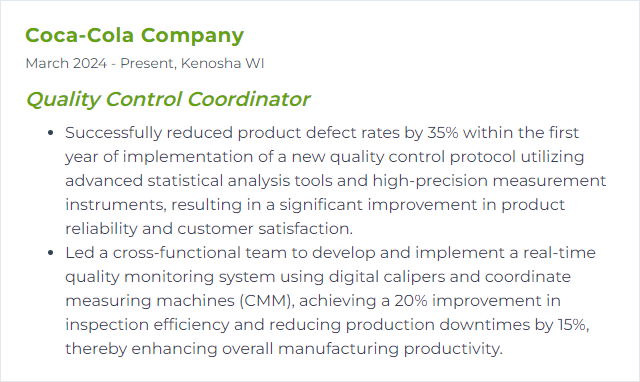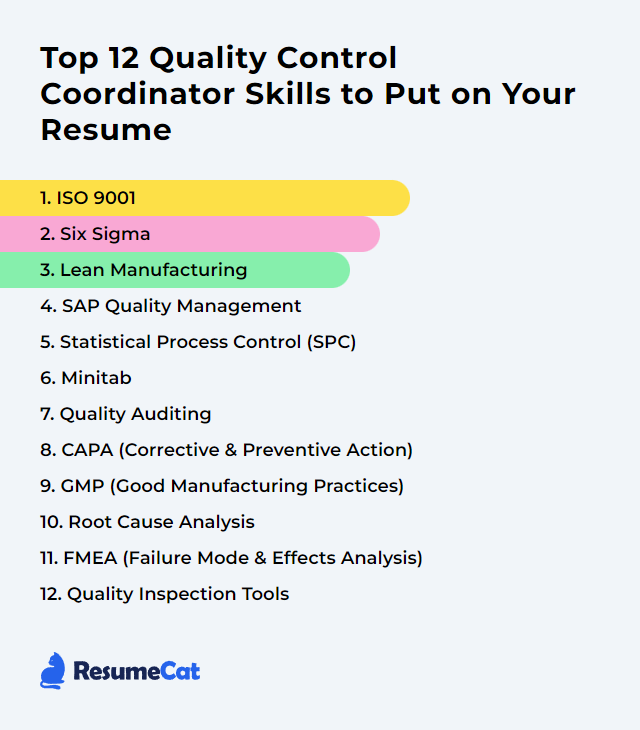Top 12 Quality Control Coordinator Skills to Put on Your Resume
In today’s crowded hiring landscape, a Quality Control Coordinator has to show more than familiarity with checklists. You need proof you can build reliable systems, crush variation, and keep compliance tight while production moves fast. The skills below deserve prime space on your resume. Use them to frame your impact with clarity, numbers, and a story of steady improvement.
Quality Control Coordinator Skills
- ISO 9001
- Six Sigma
- Lean Manufacturing
- SAP Quality Management
- Statistical Process Control (SPC)
- Minitab
- Quality Auditing
- CAPA (Corrective and Preventive Action)
- GMP (Good Manufacturing Practices)
- Root Cause Analysis
- FMEA (Failure Mode and Effects Analysis)
- Quality Inspection Tools
1. ISO 9001
ISO 9001 is the global benchmark for quality management systems. It frames how organizations define processes, meet requirements, and keep customers satisfied through continual improvement.
Why It's Important
For a Quality Control Coordinator, ISO 9001 anchors consistency. It connects everyday work—procedures, records, metrics—to customer and regulatory needs, raising reliability while trimming waste.
How to Improve ISO 9001 Skills
Lead from the top: Secure visible management commitment and set quality objectives that matter to the business.
Build competence: Train teams on procedures, risk-based thinking, and problem-solving. Keep roles and authorities unmistakably clear.
Use the process approach: Map key processes, define inputs/outputs, owners, and interactions. Control changes deliberately.
Drive PDCA: Plan-Do-Check-Act relentlessly. Review KPIs, run corrective action to closure, and standardize wins.
Listen to customers: Collect and act on feedback, complaints, and returns data. Turn signals into improvements.
Manage risk: Identify risks and opportunities, apply controls, and revisit them as data shifts.
Audit and measure: Use internal audits and management reviews to test effectiveness, not just conformity.
Control suppliers: Qualify, monitor, and develop suppliers using scorecards and periodic assessments.
How to Display ISO 9001 Skills on Your Resume
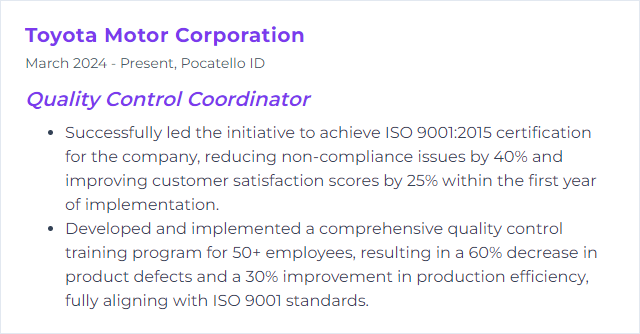
2. Six Sigma
Six Sigma is a data-centric method to reduce variation and defects. It uses structured projects and statistics to sharpen processes and outcomes.
Why It's Important
It cuts rework, improves yield, and translates directly into lower cost and happier customers. Perfect territory for a Quality Control Coordinator to show measurable impact.
How to Improve Six Sigma Skills
Go deeper on DMAIC: Execute Define-Measure-Analyze-Improve-Control with rigor. Clear problem statements, verified data, locked-in controls.
Elevate analytics: Grow capability in hypothesis tests, regression, DOE, and capability analysis. Use the right tool for the signal.
Blend Lean + Six Sigma: Remove waste first, then tame variation. Faster gains, sturdier results.
Select projects wisely: Prioritize by business value and feasibility. Protect scope. Track cost savings and defect reduction.
Engage stakeholders: Align with operators, engineers, and leadership early. Co-create solutions so they stick.
Standardize control: Visual management, control plans, layered audits—keep the gains from slipping.
How to Display Six Sigma Skills on Your Resume
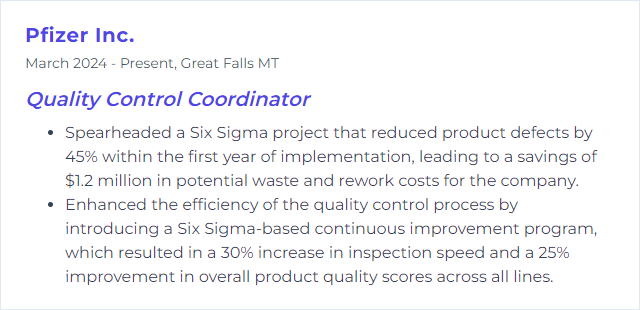
3. Lean Manufacturing
Lean focuses on maximizing value while removing waste—motion, waiting, defects, overproduction, the whole crew. It simplifies flow and stabilizes quality.
Why It's Important
Quality improves when processes are crisp. Less clutter, fewer handoffs, shorter cycles. Lean sets the stage for repeatable outcomes.
How to Improve Lean Manufacturing Skills
Kaizen everyday: Small, frequent improvements beat massive overhauls. Involve the people who do the work.
5S the workspace: Sort, Set in order, Shine, Standardize, Sustain. Make the right way the easy way.
Value stream map: See the end-to-end flow. Spot bottlenecks, queues, and rework loops. Target lead time.
TPM discipline: Prevent breakdowns and defects with operator-led maintenance, OEE tracking, and quick changeovers.
Standard work: Document best-known methods. Train to standard. Audit gently, improve often.
Rapid problem-solving: 5 Whys, A3 thinking, visual controls. Fix at the source.
Cross-train: Build flexibility and resilience. Absences won’t crater quality.
Communicate openly: Daily standups, andon triggers, simple dashboards. Issues surface fast.
How to Display Lean Manufacturing Skills on Your Resume
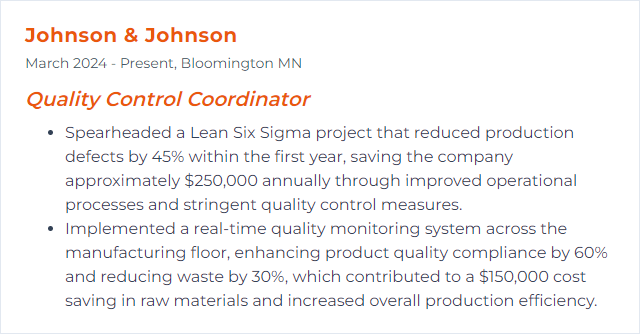
4. SAP Quality Management
SAP Quality Management (QM)—in SAP ERP and SAP S/4HANA—ties quality planning, inspections, notifications, and certificates into procurement, production, and sales. One source of truth across the supply chain.
Why It's Important
It embeds quality at the point of action. Incoming inspections, in-process checks, usage decisions, supplier quality—connected and auditable.
How to Improve SAP Quality Management Skills
Know the building blocks: Master inspection plans, characteristics, lots, sampling procedures, and catalogs. Understand how they link to materials and operations.
Exploit integration: Connect QM with MM, PP, SD, and EWM. Automate inspection lot creation and quality blocks to prevent escapes.
Use analytics: Set up dashboards (e.g., in S/4HANA and embedded analytics) for defect trends, costs of poor quality, and supplier performance.
Streamline notifications: Standardize defect coding, priorities, workflows, and CAPA tracking within QM notifications.
Template wisely: Create reusable master data (plans, MICs, sampling) with clear governance to avoid duplication.
Automate where sensible: Leverage batch jobs, quality info records, and digital signatures to reduce manual touch.
Partner with IT: Tune authorizations, roles, and performance. Validate changes through a controlled transport path.
How to Display SAP Quality Management Skills on Your Resume
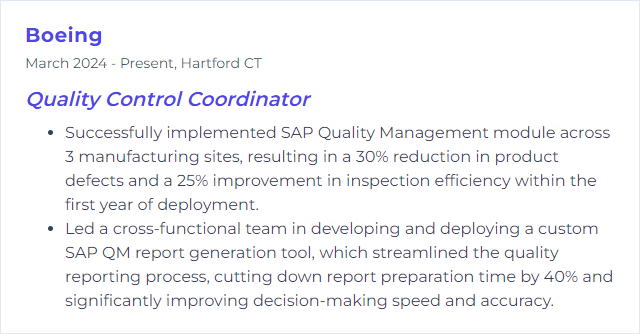
5. Statistical Process Control (SPC)
SPC uses statistics—especially control charts—to watch processes in real time. Signal or noise? The charts tell you when to act.
Why It's Important
It prevents bad quality instead of sorting it later. Fewer surprises, tighter capability, cleaner costs.
How to Improve Statistical Process Control (SPC) Skills
Pick the right charts: X̄-R, X̄-s, I-MR, p, np, c, u—match data type and subgrouping to the correct chart.
Standardize data collection: Clear sampling rules, time stamps, lot ties. Garbage in, chaos out.
React to rules: Train teams on Western Electric/AIAG rules. When the chart speaks, act fast and locally.
Go beyond charts: Capability indices (Cp, Cpk, Pp, Ppk), Pareto, box plots. See variation from multiple angles.
Monitor in real time: Use automated data capture and alerts. Shorten the interval between signal and correction.
Close the loop: Tie out-of-control events to root cause and CAPA. Verify effectiveness on the chart.
How to Display Statistical Process Control (SPC) Skills on Your Resume
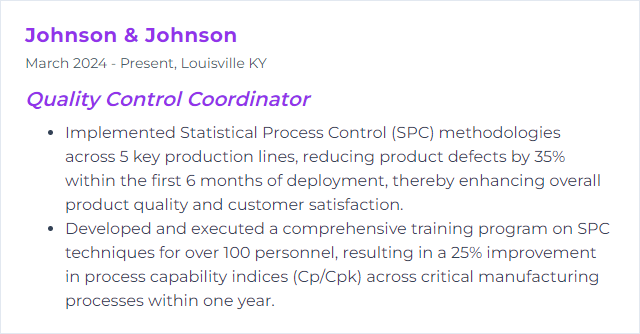
6. Minitab
Minitab is a stats workbench for quality pros. Control charts, capability, DOE, regression, Monte Carlo—analysis that turns data into action.
Why It's Important
It accelerates problem-solving and makes evidence-based decisions feel obvious. Visuals that persuade. Numbers that hold up.
How to Improve Minitab Skills
Master the essentials: Control charts, capability, GR&R, hypothesis tests, power and sample size.
Climb to advanced: DOE (screening, factorial, RSM), logistic regression, time series, nonparametrics.
Template your workflows: Build macros and standardized worksheets for recurring analyses.
Tell the story: Clean graphs, clear conclusions, practical recommendations. Decision-makers remember clarity.
Practice on real data: Short cycles of analysis → change → verification. Skill compounds quickly.
How to Display Minitab Skills on Your Resume
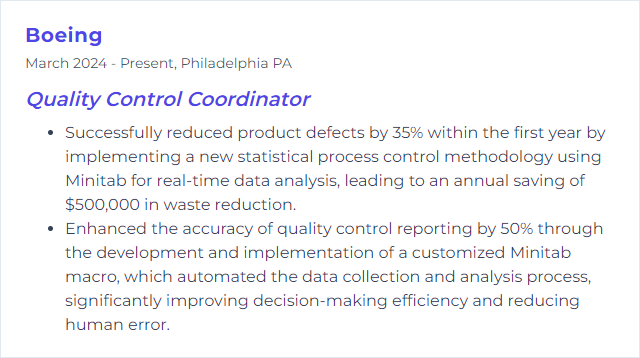
7. Quality Auditing
Quality auditing is a systematic check of whether your system does what it claims—and whether that’s good enough to meet objectives and requirements.
Why It's Important
Audits surface gaps before customers do. They verify compliance, strengthen processes, and feed management reviews with evidence.
How to Improve Quality Auditing Skills
Follow solid guidance: Base programs on recognized auditing principles (e.g., ISO 19011). Plan risk-based audits.
Sharpen checklists: Tie them to procedures, risks, and past nonconformities. Probe effectiveness, not just existence.
Strengthen objectivity: Separate auditors from their own processes. Calibrate the audit team for consistency.
Write crisp findings: Evidence, criteria, statement of nonconformity—clean and actionable.
Close the loop: Verify corrective actions for root-cause depth and sustained effectiveness.
Digitize smartly: Use audit scheduling, issue tracking, and dashboards to spot trends across sites and processes.
How to Display Quality Auditing Skills on Your Resume
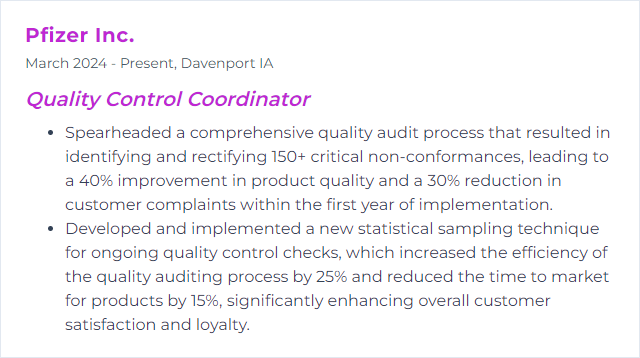
8. CAPA (Corrective and Preventive Action)
CAPA systematizes how you capture problems, find causes, fix them, and keep them from returning. In regulated spaces (e.g., medical devices), it’s a core compliance pillar.
Why It's Important
It turns incidents into improvements. Done well, CAPA reduces recurrence, boosts reliability, and satisfies auditors.
How to Improve CAPA (Corrective and Preventive Action) Skills
Separate correction from corrective action: Immediate fix vs. root-cause removal. Don’t confuse the two.
Scope crisply: Clear problem statements, defined containment, and risk assessment to prioritize work.
Use robust RCA: 5 Whys, Fishbone, fault tree, 8D—pick methods that fit the problem and data.
Plan with teeth: Owners, due dates, resources, verification steps. Make actions verifiable, not vague.
Verify effectiveness: Check metrics post-implementation. If the signal doesn’t move, revisit the cause.
Integrate with QMS: Link CAPA to audits, complaints, deviations, and change control. Visibility prevents repeat pain.
Mind the standard: For ISO 9001, embed risk-based thinking. For ISO 13485/21 CFR 820, meet formal CAPA expectations end to end.
How to Display CAPA (Corrective and Preventive Action) Skills on Your Resume
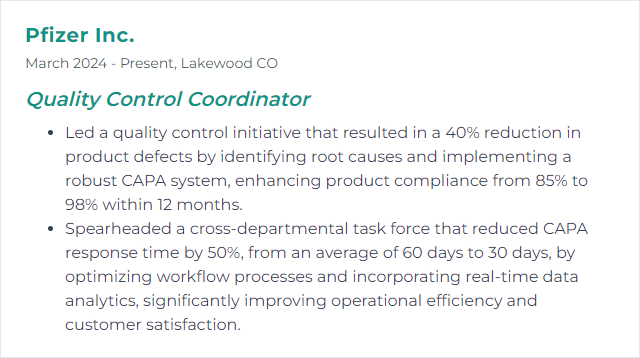
9. GMP (Good Manufacturing Practices)
GMP defines the rules of the manufacturing floor: qualified people, validated processes, controlled changes, clean records, fit-for-purpose facilities.
Why It's Important
Safety and efficacy can’t be tested into the product at the end. GMP builds quality into every step and proves it with documentation.
How to Improve GMP (Good Manufacturing Practices) Skills
Stay current: Track applicable regulations and guidance (e.g., FDA, EU, WHO). Update SOPs and training accordingly.
Train continuously: Role-based, periodic refreshers. Verify effectiveness, don’t just record attendance.
Document rigorously: ALCOA+ principles—Attributable, Legible, Contemporaneous, Original, Accurate, plus completeness and consistency.
Validate and qualify: Equipment, utilities, methods, and processes. Maintain change control and periodic review.
Audit suppliers: Qualification, ongoing monitoring, and quality agreements. Materials make the product.
Preventive maintenance: Calibrations, PM schedules, and deviation handling. Reliability protects product quality.
Manage deviations: Investigate thoroughly, implement CAPA, trend the data, and escalate patterns.
How to Display GMP (Good Manufacturing Practices) Skills on Your Resume

10. Root Cause Analysis
Root Cause Analysis digs past symptoms to the underlying drivers of failure. Fix the cause, and the symptom fades.
Why It's Important
It stops firefighting. RCA reduces recurrence, stabilizes quality, and frees time for proactive work.
How to Improve Root Cause Analysis Skills
Define precisely: Problem statement, where/when, magnitude, and boundaries. Loose definitions waste time.
Gather clean evidence: Data, photos, parts, logs, process parameters. Verify facts before theorizing.
Use the right tools: 5 Whys, Ishikawa diagrams, fault tree, 8D, cause-and-effect matrices. Mix qualitative and quantitative.
Test the cause: Reproduce the issue or simulate. Statistical analysis helps confirm the suspected driver.
Implement robust actions: Error-proofing, standard work changes, design tweaks—solutions that survive turnover and time.
Sustain and share: Verify effectiveness with data. Capture lessons learned and update procedures and training.
How to Display Root Cause Analysis Skills on Your Resume
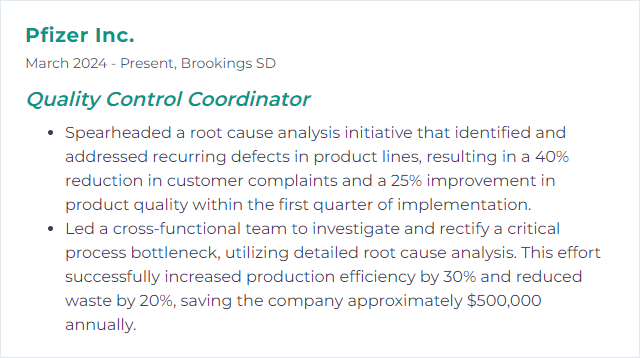
11. FMEA (Failure Mode and Effects Analysis)
FMEA anticipates how things might fail, estimates risk, and drives preventive actions before problems reach customers.
Why It's Important
It prioritizes attention. High-risk failure modes get focused mitigation, improving reliability and safety upfront.
How to Improve FMEA (Failure Mode and Effects Analysis) Skills
Use the latest guidance: Align with recognized handbooks (e.g., AIAG & VDA) for consistent ratings and methodology.
Staff cross-functional teams: Design, manufacturing, quality, service. Diverse eyes see more risk.
Ground in data: Field returns, test results, SPC trends, warranty claims. Evidence > guesses.
Focus on action: Don’t stop at scoring. Assign owners, due dates, and verify risk reduction post-action.
Keep it living: Update after design changes, process shifts, and new learnings. Stale FMEAs mislead.
Link to controls: Control plans, error-proofing, and inspection plans should reflect the FMEA’s priorities.
How to Display FMEA (Failure Mode and Effects Analysis) Skills on Your Resume

12. Quality Inspection Tools
Inspection tools span hand gauges to CMMs, vision systems, torque analyzers, spectrometers, and software that crunches results in real time.
Why It's Important
Accurate measurement proves conformity. It spots drift early, protects customers, and feeds improvement with hard data.
How to Improve Quality Inspection Tools Skills
Modernize smartly: Digital calipers, wireless gauges, AOI/vision, 3D scanning—speed up checks and reduce transcription errors.
Calibrate religiously: Defined intervals based on risk, with traceability and environmental controls.
Standardize methods: Clear measurement procedures, fixturing, and GR&R studies to confirm repeatability and reproducibility.
Integrate data: Pipe results into SPC dashboards and QMS records for trend spotting and faster action.
Train operators: Hands-on practice, visual guides, and periodic proficiency checks.
Close feedback loops: Use inspection trends to refine tolerances, improve designs, and adjust processes.
Design for inspectability: Collaborate early so features are measurable cheaply and reliably.
How to Display Quality Inspection Tools Skills on Your Resume
